| 105
|
CHAPTER 16
Plastic Bottles to Correct
Margarita's Turned-In Feet,
and to Heal Jesús' Pressure Sore
A PLASTIC BOTTLE FOOT-TUBE FOR MARGARITA
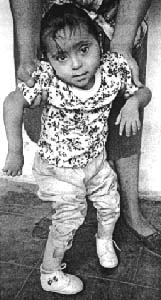
MARGARITA was born with club feet (equino-varus).
When she was one month old, her parents took her to PROJIMO. The village
team put her feet in plaster casts for 6 weeks, and gradually corrected the
deformities. Then they made plastic braces to hold her feet in a slightly
over-corrected position.
One year later, Margarita began to walk. When she was 1 year and 4
months old, she was walking fairly well. However her mother was concerned
about her "pigeon-toed" feet. Indeed, when she walked, her feet turned
inward a lot. On examining her, this appeared to be due in part to the
position of her feet in relation to her legs, and in part to inward rotation
of her hips.
Margarita's parents had taken her to an orthopedist who prescribed a
device, for use at night, that would hold her feet turned outward
(externally rotated). This involved a metal bar attached to
outwardly-rotated orthopedic shoes. The bar and shoes would cost the family
over 800 pesos (US$ 100.00). Short of money, the family returned to PROJIMO
to see if a less costly solution could be found.
A Simple, Low-Cost Alternative
To create a night-appliance that would hold Margarita's feet in an
outwardly-rotated position, the PROJIMO team improvised a simple device
using a half-liter plastic bottle. It only took about 5 minutes to make, and
it cost nothing. The same high-top shoes and plastic braces that the child
wore during the day could be used with the foot-tube at night. No other
equipment or costs were required.
To make the foot tube, a long, slender plastic bottle
can be cut with a knife (or an electric grinder). Remove both ends, and cut
an oval in the middle of the bottle, just large enough to fit both feet
through it.
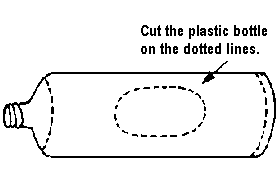
 |
| 106
|
| When the new device was tried, Margarita seemed
comfortable. However, her parents worried that she would fret and be
unable to sleep at night with her feet confined. The PROJIMO team
advised them to start by putting the appliance on Margarita's feet
for short periods. As she got more used to it, the time could
gradually be extended. |
 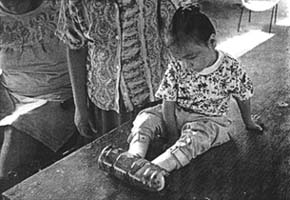 |
|
RESULTS: After two
months of using the "foot-tube" appliance at night, Margarita's parents
agreed that she was walking with her feet in a more normal, less turned-in
position.
| DUPLICABILITY AND ADAPTABILITY:
This appliance has since been made for another child, with a piece
of soft-plastic water pipe (stiff, but with moderate flexibility).
With the plastic pipe, the feet can be separated, as well as
outwardly-rotated. |
 |
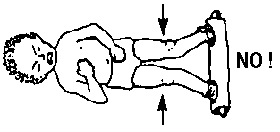 |
CAUTION: This plastic bottle method cannot be
recommended for all children with in-turned feet. It worked
for Margarita, whose feet could easily be opened widely. But if a
child's feet do not open easily, or if the rotation appears to be
forcing the hips or knees into a distorted position, don't use it. |
| If the feet cannot be rotated outward easily by hand,
it is better to use a device that will rotate them more gradually. The
shoes can be screwed to a wood or metal cross-bar like this.
If you have to use force, or if it hurts, don't do it. |
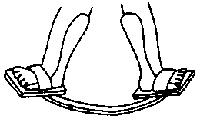 |
|
| 107
|
A PLASTIC-BOTTLE FOOT PROTECTOR FOR JESUS
JESÚS is a boy who was born with spina bifida, a defect in the
spinal-cord that causes paralysis and reduced feeling in his legs and feet
(see page 131).
Chapter 45 explains how Jesús became involved in Child-to-Child
activities with other children and school teachers. Here, we look only at
the problem of chronic sores on his foot.
Jesús' loss of feeling from his hips to his feet has caused repeated
problems. As a young child he was able to walk, although with considerable
difficulty. Sores developed on his right foot and because he had no
feeling in his foot he continued walking on it. Infection set in, spread
to the bone, and eventually the whole foot was dangerously infected. When
he was 6 years old, his lower leg had to be amputated (cut off).
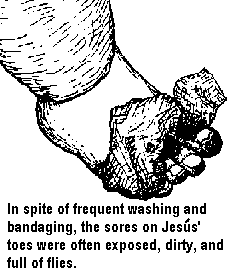
When Jesús first came to PROJIMO, he had pressure sores on his backside,
which were the result of reduced feeling. From crawling around on all
fours, he also had sores on his stump and on the toes of his left foot.
To keep pressure off the sores on his bottom, the PROJIMO team had
Jesús spend time on a wheeled cot (called a gurney, see
Chapter 37). Inez cleaned his sores daily,
and treated them with honey. The pressure sores on his backside were
healing well. But the sores on his toes grew bigger and deeper. The
problem was that Jesús was very active. He kept bumping or scraping his
toes, or lying with them pressed against the gurney. The bandages quickly
got dirty and matted. Mari told him to be more careful, but since he felt
no pain in the open sores, he was careless. Unless a way could be found to
protect Jesús' foot, Mari was afraid that his left leg might also
eventually have to be amputated. What to do?
| A simple device was needed that
would protect Jesús' injured toes from all sides, yet would let air
circulate freely (especially because the weather was extremely hot).
Marcelo, the brace and limb maker, found a solution. He riveted the
bottom half of a square plastic bottle to Jesús' plastic lower-leg
brace. It fit around the end of Jesús' foot and shielded the toes
without touching them. |
 |
|
| 108
|
| RESULTS. Pleased with his
new device, Jesús took care to use it all day long. The results were
impressive. In 4 days the sores were dry, clean, and well on their way
toward healing.
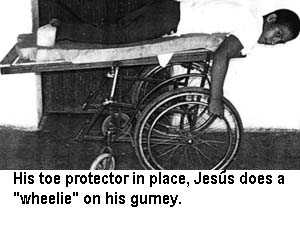

|
|